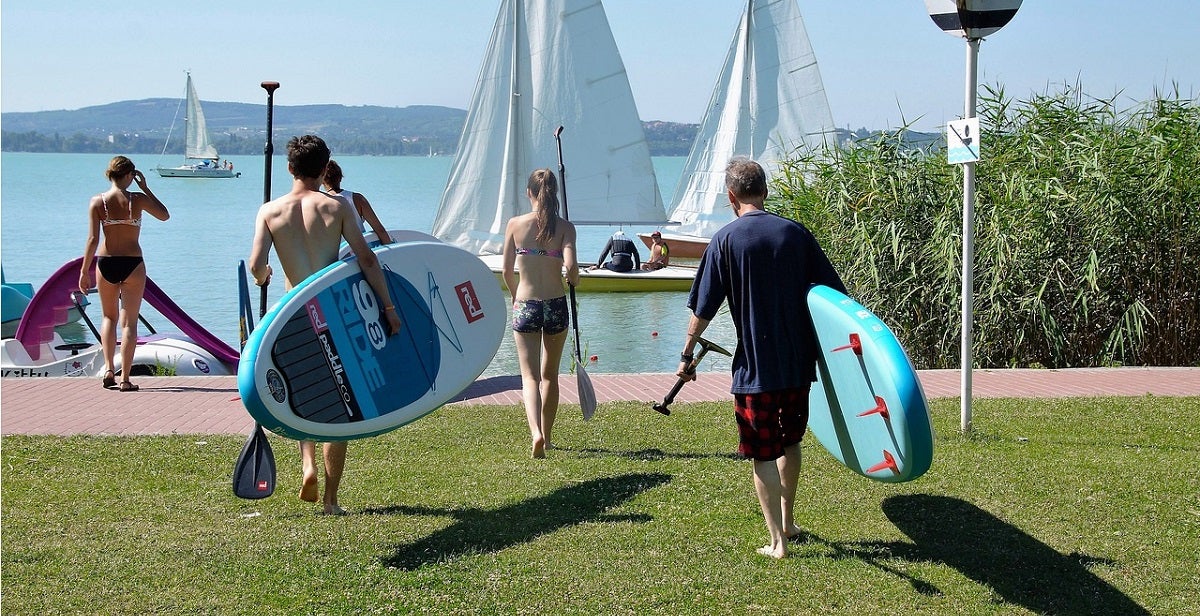
Our Editors independently research, test, and rate what we feel are the best products. We use affiliate links and may receive a small commission on purchases.
There are many physical activities that people take up as hobbies, and it differs for each person.
You might be the type of person who likes to go mountaineering or hiking. If you’re a person who likes going to water-based activities, you’re likely into paddle boarding or kayaking. However, what if you combine both of these?
A lot of people find that aside from bringing their camping gear and their hiking poles with them, having a stand-up paddle board is also a great accessory for short term hikes.
Stand-up paddleboard (SUP) and hiking are becoming a popular activity amongst nature lovers and adventure seekers. The same thing goes with SUP camping, only you bring your camping gear instead of your hiking gear.
Having an inflatable SUP makes the hike a lot more interesting if you want to bring your hiking game to the next level. It feels like you’re traversing a whole new world and getting more out of your hike with a SUP.
Of course, there are newer challenges that you might encounter when traveling with paddle boards. To help you, here are five useful tips that you should know when traveling with paddle boards:
Find a High-Quality Backpack
It would be best if you learn how to protect your paddle boards before you get to your destination. And one of the best ways to protect it would be to get a high-quality backpack or paddle board bag.
At the same time, it’s going to make it easier for you to carry your paddle board to the destination.
If you plan on bringing your epoxy paddle board with you, you need to be extra careful with it. However, inflatable boards are a lot easier to travel with, especially when going outside of the country.
Get a 3-Piece Travel Paddle
Aside from the main paddle board itself, you need to make sure that you get yourself a SUP paddle.
Of course, since you’re going to be traveling to faraway places with your paddle board, you should have yourself a three-piece travel paddle. A three-piece travel paddle can be divided into three pieces, making it a lot easier to pack.
When choosing your three-piece travel paddle, however, there are a couple of things you need to consider. First of all, you need to make sure it’s durable. Your luggage goes through quite a bit of stress before it gets to the destination. You don’t want to finally get to the destination only to find a broken paddle.
You also want to make sure that it’s lightweight. It will make it easier to use, and it will also reduce the chances of you going over the weight limit.
Roll Up Your Pump and Paddle
Here is a step-by-step on how to roll up your paddle board for travel:
- Start at the tail and open the exhaust there.
- Start rolling the SUP at the nose. That way, the air releases through the tail.
- Use the “IN” mode of your SUP so you can deflate the SUP easier. Don’t let sand or debris get into the SUP valve.
- Once the air is out and the SUP is flat, turn up the valve pin and then put on the dust cover.
- Don’t fold the fins to lengthen their lifespan.
- Tighten the strap of the SUP as much as possible, so the roll is tighter. Tightening it will make it easier for you to pack it away.
How to Deflate a Paddle Board
Wrap Your Backpack
As mentioned before, your luggage goes through quite a bit of abuse from the travel, so you need to make sure it has the right protection.
There are plenty of commercially-available paddleboard bags in the market that have padding in them. If you want to be extra safe, then you should add more cushion to your board.
You can also use a variety of items to pad your paddle board backpack. Some people use blankets to pad it up. Others use bubble wrap and even insulating foam.
As long as you have some protection in place against impact, you should be good to go.
Meet Your Airline’s Weight Limit
Different airlines have different weight limits. Therefore, you should check what the limits are first.
It’s not a good idea to believe in a standard weight limit. However, given the size of your paddle board, you might want to prepare for the excess baggage fee.
Aside from the weight limit, you need to be conscious of the size limits too. Since paddle boards are large, they might be testing the boundaries of the size and weight requirements that airlines allow you.
To Sum Up
Traveling with paddle boards is undoubtedly a new experience. Still, it’s adding that extra something that will make your trip feel like a huge adventure.
Knowing the useful tips listed above beforehand will reduce the surprises you might get when traveling with paddle boards for the first time. Aside from that, it adequately prepares you for what to expect.
Hopefully, as time goes, traveling with paddle boards will become more comfortable for you. Apply these useful tips, so you don’t feel too much travel snags along your journey.
